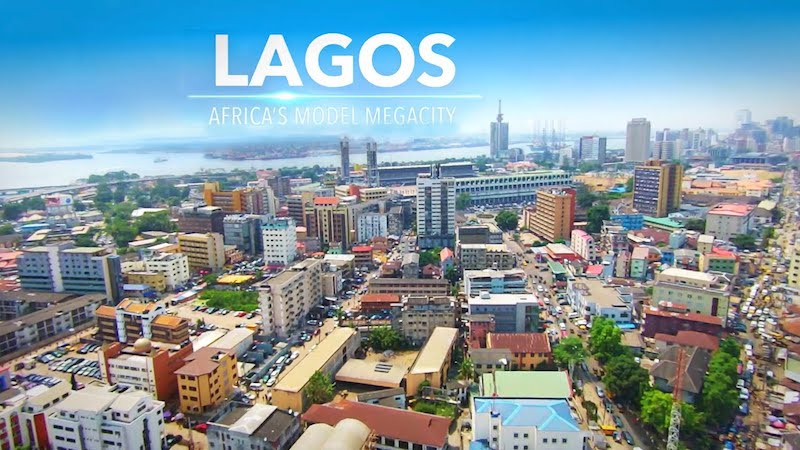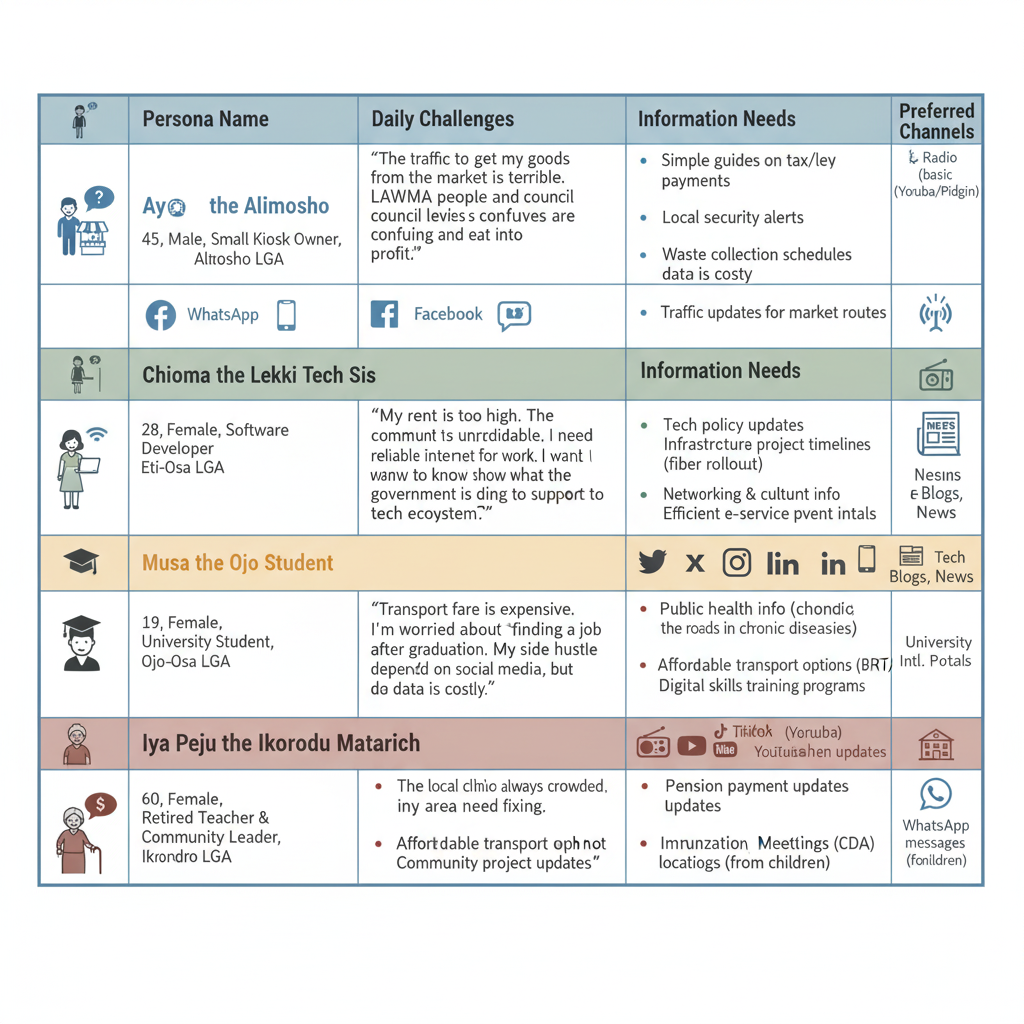Case Study: Architecting a Citizen-Centric Digital Content Strategy for the Lagos State Government
Website: www.lagosstate.gov.ng

The Challenge: Connecting with 20 Million Citizens in Africa's Largest Megacity
The Lagos State Government (LSG) governs one of the world's fastest-growing urban areas, a dynamic and complex megacity with a population exceeding 20 million people. In a mobile-first environment with the highest internet penetration in Nigeria, the government faced a critical communications challenge.
Its digital presence was extensive but fragmented across numerous Ministries, Departments, and Agencies (MDAs), leading to inconsistent messaging and a confusing citizen experience. Key government communications, framed around the internal T.H.E.M.E.S.+ policy agenda, failed to resonate with the daily realities of residents grappling with traffic, housing, and sanitation. This created a significant trust deficit, which was amplified by the rapid spread of online misinformation.
We were tasked with transforming the LSG's digital communications from a series of disparate announcements into a cohesive, citizen-centric engagement ecosystem designed to build a #GreaterLagos.
Our Strategic Solution: A Unified Content Architecture
We developed a comprehensive, data-driven strategy to overhaul the LSG's approach to digital communication. Our framework was built on a foundational mission: "To build a #GreaterLagos by empowering every resident with timely, accessible, and actionable information; fostering transparent dialogue; and demonstrating a government that listens, cares, and delivers."
This mission was guided by four core principles: Citizen-Centricity, Transparency, Accessibility, and Responsiveness.
1. Translating Policy into Citizen-Centric Content Pillars
A core part of our strategy was to reframe the government's internal T.H.E.M.E.S.+ agenda into external-facing content pillars that addressed the direct needs and concerns of Lagosians. This shifted the narrative from policy-speak to problem-solving.
- Pillar 1: Navigating Lagos (From Traffic Management & Transportation)
- Focus: Making the daily commute easier and safer.
- Content Examples: Real-time traffic updates via LASTMA and Lagos Traffic Radio, guides on using BRT and ferry services, and tutorials for the LAGOSRIDE app.
- Focus: Improving public health and the urban environment.
- Content Examples: Public health campaigns on malaria and immunization, LAWMA waste collection schedules, and directories of Primary Healthcare Centers (PHCs).
- Focus: Highlighting educational opportunities and fostering innovation.
- Content Examples: Information on public school admissions and scholarships, promotion of state-run digital literacy programs, and updates on digital infrastructure investments.
- Focus: Creating pathways to economic prosperity.
- Content Examples: Step-by-step guides for SMEs on business registration and tax payment, and success stories from the Lagos State Employment Trust Fund (LSETF).
- Focus: Showcasing the city's cultural vibrancy.
- Content Examples: Promoting cultural festivals like the Lagos Countdown and creating guides to tourist attractions and historical sites.
Pillar 6: Safe & Accountable Lagos (From Security & Governance)
- Focus: Enhancing public safety and building trust through transparency.
- Content Examples:
Public safety campaigns, simple explanations of new laws, and a "You
Reported, We Fixed" content series showcasing resolved issues from the
Citizens Gate platform.
2. Developing Hyper-Relevant Audience Personas
To ensure content was targeted and empathetic, we developed detailed audience personas based on the city's demographic realities. These archetypes guided decisions on content format, tone, language, and channel selection.

3. Implementing a Multilingual Voice Strategy
Recognizing Lagos's linguistic diversity, we implemented a strategic multilingual approach. While Formal English remained the language for the official website (lagosstate.gov.ng) and formal documents, we integrated Nigerian Pidgin and Yoruba
into social media campaigns and public service announcements. This move
was designed to enhance reach, authenticity, and accessibility,
particularly among youth and grassroots communities, where Pidgin is the
de facto lingua franca.
Activation: Governance, Operations, and Crisis Management
To execute the strategy, we designed and implemented a new operational framework.
1. The "Hub and Spoke" Governance Model
We replaced the fragmented communication structure with a "Hub-and-Spoke" model.
- The Hub: A central strategy team was established within the Ministry of Information & Strategy to set guidelines, manage core platforms like the main @followlasg accounts, and provide support.
- The Spokes: Communications officers within each MDA (e.g., Ministry of Health, LASTMA, LAWMA) acted as subject-matter experts, creating specialized content aligned with the central strategy.
This model ensured a unified government brand while empowering agencies to communicate with accuracy and depth.
2. Proactive Narrative and Crisis Management
To counter misinformation and shift from a reactive to a proactive posture, we established a rapid-response protocol.
- Social Listening: We implemented social listening tools to monitor public sentiment and detect emerging false narratives in real-time.
- Rapid Response: A clear protocol was created to quickly verify facts and deploy accurate information through official channels before misinformation could become entrenched.
- Fact-Checker Collaboration: We initiated strategic partnerships with independent fact-checking organizations like Africa Check and Dubawa to build a broader ecosystem of truth and lend third-party credibility to the government's clarifications.
3. Closing the Feedback Loop: #EkoReportsWeRespond
A key initiative to rebuild public trust was the creation of a weekly branded content series: "#EkoReportsWeRespond." This series visually demonstrated the government's responsiveness by showcasing citizen complaints submitted via the Citizens Gate portal or social media, alongside evidence of the resolved issue. This provided tangible proof that the government was listening and acting.
The Impact: Building a More Engaged and Trusting #GreaterLagos
The implementation of this citizen-centric content strategy yielded significant, measurable benefits for the Lagos State Government and its residents.
- Increased Public Trust: By communicating with empathy, transparency, and in the languages of the people, we helped reduce the credibility gap between the government and its citizens. The #EkoReportsWeRespond series became a powerful tool for demonstrating accountability.
- Higher Uptake of Digital Services: Clear, accessible guides and targeted campaigns led to more efficient use of the 200+ online government services available on lagosstate.gov.ng, from tax payments to permit applications.
- Enhanced Crisis Communication: The proactive narrative management protocol substantially improved the government's ability to manage public information during health emergencies, security incidents, and other crises.
- A More Informed and Engaged Citizenry: The strategy transformed the relationship between the government and the people it serves, fostering a more informed and participatory civic environment.
By architecting this new framework, we helped position the Lagos State Government as a leader in digital governance on the African continent, creating a virtuous cycle of communication, engagement, and responsive governance for a truly #GreaterLagos.
